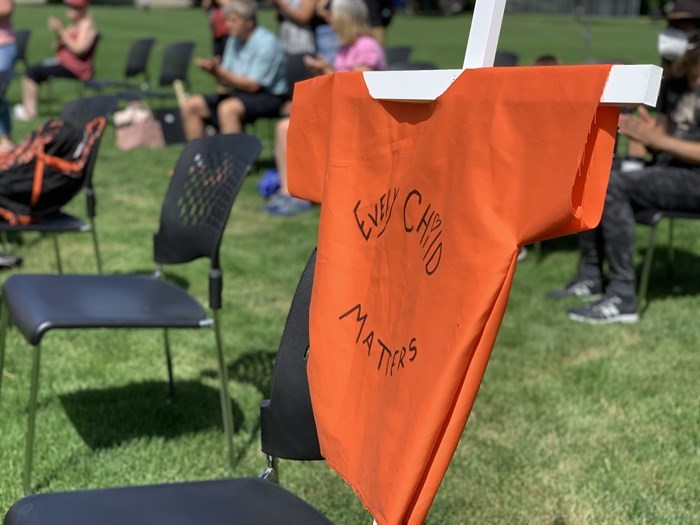
The Ki-Low-Na society held a healing walk, traditional food, drumming, and speeches from elders, residential school survivors, and local dignitaries.
(KATHY MICHAELS - EDITOR / iNFOnews.ca)
June 21, 2021 - 3:22 PM
Edna Terbasket struck a hopeful note at the end of an otherwise pointed speech given to those gathered in Kelowna for National Indigenous Day, an occasion this year honouring the 215 children whose remains were discovered at a Kamloops residential school.
“My mother made a comment, she said those 215 plus kids were found for reason — it is giving us the opportunity to start healing, and to be open and honest, like really honest,” the executive director of the Ki-Low-Na society told the crowd today, June 21.

The Ki-Low-Na society held a healing walk, traditional food, drumming, and speeches from elders, residential school survivors, and local dignitaries.
(KATHY MICHAELS - EDITOR / iNFOnews.ca)
“For you mainstream people who don't know a lot of our Canadian history, I encourage you to go out and educate yourself. Go take Indigenous 101. Go and talk to some elders…. It might be very uncomfortable for you, but they will make you understand and have empathy.”
Terbasket knew she was speaking to a supportive crowd, many of whom signalled that by being clothed in orange, and said she was thankful for the love. But she also reminded them that the harms suffered by Indigenous people go beyond the Kamloops grave discovery and it’s time more Canadians understood the breadth of the situation.
“I'd like to acknowledge the words of the RCMP (who spoke today), you know, they play a big part in our history and some of it is good,” she said. “Because they said some good words today, I don't want people to forget how some of our people have been treated and not too long ago.”
Terbasket said that for the justice system as it is in Canada, Indigenous people are big business.
“A lot of ours are the ones who are incarcerated. And they employ a lot of non-Indigenous people,” she said.
That’s something that’s been made clear by the Correctional Investigator of Canada, Dr. Ivan Zinger, who issued a report on the topic in 2020.

The Ki-Low-Na society held a healing walk, traditional food, drumming, and speeches from elders, residential school survivors, and local dignitaries.
(KATHY MICHAELS - EDITOR / iNFOnews.ca)
“Four years ago, my office reported that persons of Indigenous ancestry had reached 25% of the total inmate population. At that time, my office indicated that efforts to curb over-representation were not working. Today, sadly, I am reporting that the proportion of Indigenous people behind bars has now surpassed 30%,” he said.
In contrast, Indigenous people only represent 5% of the general Canadian population.
Zinger also found custody rates for Indigenous people have accelerated, despite an overall decline in the inmate population. Since April 2010 the Indigenous inmate population has increased by 43.4% (or 1,265), whereas the non-Indigenous incarcerated population has declined over the same period by 13.7%.
Terbasket also took aim at the education system.
“You know, there's still some of our kids who are pushed through the system and they graduate without a Dogwood,” she said. “So if they want to go to university or post secondary, then they need to spend a couple of years to upgrade. That shouldn't be happening. They should be side by side with all the other students.”
The B.C. Teachers Federation in 2018 said the six-year Dogwood completion rate of Indigenous students increased from 46.8% to 69.6% in the last 15 years. Completion rates for non-Indigenous students is 86.5% up from 81.9% in the same timeframe.
Healthcare in B.C. also was scrutinized, and she said even at Kelowna General Hospital when Indigenous people go to the emergency department, they are hardly looked at.
“And a lot of them aren't even treated medically properly, and they're sent home,” she said. “Sorry, a little peek at that racism. I look at events like today (as an opportunity), where we're able to put some of those things on the table. I know we have a lot of supporters out there. I know we have a lot of people who use both ears to listen and their one mouth to talk, gently.”
Hundreds of people gathered for the ceremony, which included a walk down a portion of Harvey Avenue. Most participants wore orange shirts, drawing attention to the lost lives of the children whose remains were discovered last month. As they walked down the highway carrying placards with images of residential schools, or shirts on crosses emblazoned with the number 215, a drumbeat filled the air.
Passersby in traffic honked in support, and there were occasional cheers, as well. There were also songs, drumming, more speeches from both the Indigenous community and the RCMP and traditional dancing.
There were few representatives from local governments there other than Coun. Loyal Wooldridge.
To contact a reporter for this story, email Kathy Michaels or call 250-718-0428 or email the editor. You can also submit photos, videos or news tips to the newsroom and be entered to win a monthly prize draw.
We welcome your comments and opinions on our stories but play nice. We won't censor or delete comments unless they contain off-topic statements or links, unnecessary vulgarity, false facts, spam or obviously fake profiles. If you have any concerns about what you see in comments, email the editor in the link above.
News from © iNFOnews, 2021